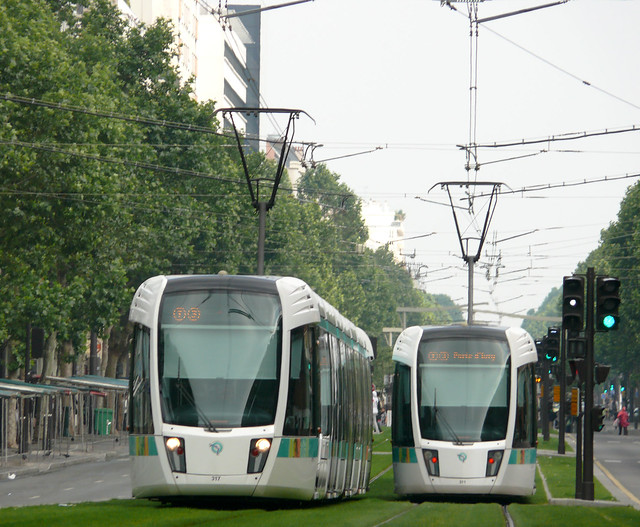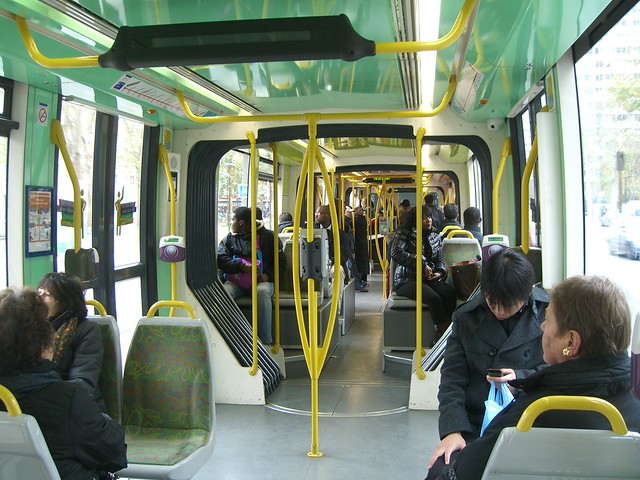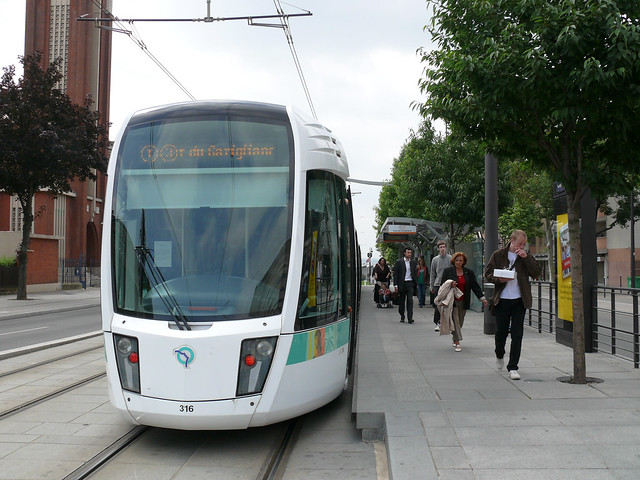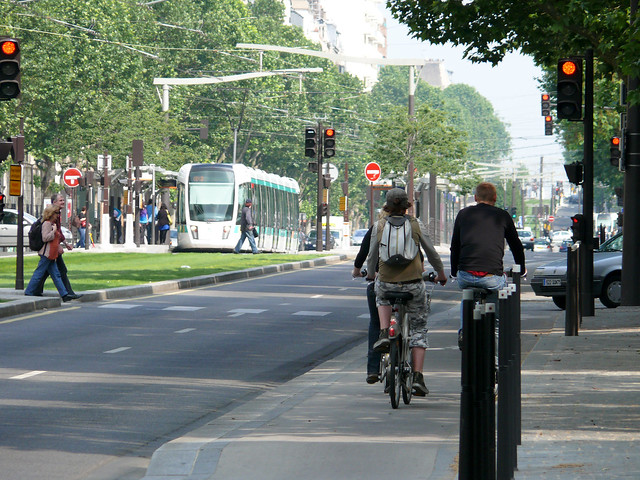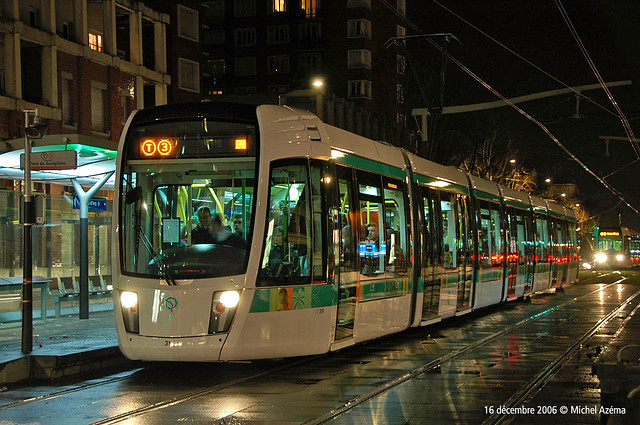
By the end of 1920s the automobilization gained momentum and the car makers along with petroleum companies gained political power. Tramway began being presented and perceived by the public as an obstacle for growing car traffic, a reason of congestion and overall as an outdated form of transport comparing to buses (which were produced and fueled by the same car and oil companies). By 1938 the pressure from the car lobby lead to a series of planning decisions which put an end to one of the most significant tramway networks of its time. Isolated lines in the suburbs were not closed until 1950s. It’s worth mentioning that exactly the same was happening in cities all over the world. As for Paris, it became an example for other French cities to remove tramway lines in favor of growing car traffic. Ironically these smaller cities suffered more than the capital because they didn’t have extensive subway systems to substitute the tram.
In 1971 French president George Pompidou stated that “cities must adapt to the car”. For decades, especially after the Second World War, automobilisation was perceived as a symbol of progress and prosperity and extensive construction of car infrastructure (highways and freeways, street widening, huge car parkings) was a priority for local, regional and national governments. But by the mid-1980s, after several oil and energy crisises and because of the growing understanding of the negative impact of car traffic on the quality of life in cities, interest for public transportation started growing again. Rapid transit such as metro and trains requires significant investing and takes a long time to build, therefore tramway as a cost-effective solution appeared on the agenda.
The first tramway lines in Ile-de-France region (T1 and T2) were built in the suburbs to the west and to the north of Paris. (Note: almost all the public transport in the capital region is run by RATP operator, so the lines are numbered independently of the municipality in which they’re laid). Tramway line T3 is the first line in the Paris proper and I would like to elaborate on it more thoroughly as it represents not only a modern transportation solution but also an innovative approach to rehabilitation of urban space.
General information
Line T3 is laid along the south segment of the so-called “marshals’ boulevards”, a series of streets that encircle Paris and mostly named after marshals of Napoleon I. These boulevards were created on the place of an old military street and the last line of parisian fortifications, the Thiers wall, which was built in 1840s and demolished after the First World War. By the standards of Paris these streets are fairly wide and suitable for the tramway line. It is worth mentioning though that there was another option – to build a light-rail line using the right of way of the abandoned Circle Railroad (Petite Ceinture) built in the late 19th century. This option promised higher commercial speeds and lower investments (the railroad passes the street network on overpasses and in tunnels) but after all it was refused because of low accessibility of future platforms and poor connection with the metro and bus lines.
The idea to build a tramline to connect peripheral neighborhoods and ‘banlieues’ of Paris was already on the table in 1920s but since trams were banished it was never realised. At the end of 1990s the ‘PC’ bus route which ran along the marshals’ boulevards was one the most saturated in Paris. It was supposed to carry as much as 50 000 passengers a day but never really reached these numbers even with articulated buses. Thus building a more efficient tramline was a logical decision. Construction began in mid-2003 and was finished in September 2006. The line was officially opened to the public on December 16, 2006.
The length of the line is 7,9 kilometers. The average distance between stations is 500 meters (there’re 17 stations). The line is served by 21 ‘Citadis 402’ trams produced by French industrial concern Alstom. The tram is a 7-carriage articulated train with fully low floor. It can carry up to 304 passengers. The commercial speed is at the moment 17-18 km/h which is lower than orignianally planned 20 km/h. The train passes the whole line in 26-27 minutes. 10 of 17 stations are interchanges with metro and bus lines, and with T2 tramline at Porte de Versailles. Tramways carry 110 thousand passengers per day which is higher by 10 thousand than it was anticipated, thus the line is definetely a success.
Rolling stock
The Citadis tram is a 43-meter long train composed of 7 articulated carriages. The driver’s cabins are located at both ends of the train so there’s no need in turning loops – at the end of the line the train just changes tracks and starts moving in the opposite direction. Interior is a single space which provides even distribution of passengers along the train. Citadis trams have 100% low floor thus allowing easy boarding and access for handicaps and mums with strollers. Interior is fairly spacious and well-lit. Triple rails are very handy at rush hours as well as special seats that one can lean on while standing.
There’re no conductors to collect fare. Most of parisians have a Navigo card – a monthly ticket for all city transport – for which there’re validators onboard. There’re also validators for single-ride tickets which can be bought in vending machines at the stations.
Stations
Comparing to the stations and platforms that we have in Yekaterinburg tramway stops in Paris can be called luxurious. They’re 4 meters wide allowing people to easily pass each other and wait for the tram in a dignified space (except maybe for rush hours when stations get crowded). Platforms are raised to the level of the tramway floor to allow single level boarding. The entrances to the platforms are designed as ramps to improve accessibility. The stations are well-protected from the car traffic. Physical protection is provided by granite barriers while the glass shields protect the passengers from spray and dust from the road, and partly muffle the noise of the traffic. The edges of platforms are marked with tactile strips for visually impaired just like in metro.
There’re various facilities at the stations. Among them are shelters, seats, ticket machines, litter bins, advertisements etc. Many platforms have trees integrated into their design which will provide additional shade and mitigate the streetscape as they grow. The shelters are worth mentioning separately. They look good during the day but they’re most impressive when it gets dark. The backlight of shelters’ segments changes randomly creating fancy light compositions: from fairly neutral to downright extravagant. Shelter backlight smoothes over the waiting time which is longer in the evening.
Tramway priority
New tramway line intersects with many perpendicular streets of which many are busy traffic gateways to the city of Paris from the south. On average line T3 intersects with a roadway every 220 meters. In this situation it was crucial to give tramways a clear priority and make them independent from car traffic. This task was solved with installation of additional traffic signals. Each time when a tram approaches an intersection these signals turn red for passing cars. The busiest intersections are also equipped with surveillance cameras that allow manual control over the traffic signals to let pass the cars if they start crowding on the tracks. At rush hours police officers may be seen at certain intersections regulating the traffic flow.
Transforming urban space
One of the main goals of building the new tramway line was to transform and revitalize the cityscape around it. Before year 2003 the south segment of marshals’ boulevards was a series of arterial streets up to 6-8 lanes wide, dominated by car traffic with all the consequences such as noise, pollution, unsafe and inconvenient crossings. The tramline reduced the roadway by 2 lanes and even more at certain places. Automobile tunnel under Porte d’Italie was closed and filled up to give space for the tram. Thus by reducing the space that traffic can take it became possible to reduce the traffic itself. According to the data of the city of Paris in 4 years after inauguration of the tramline, car traffic on marshals’ boulevards reduced by 50%. This in turn made the streets more welcoming and safe for pedestrians and cyclists. Noise levels were reduced while narrower roadways force the motorists to drive slower and to be more careful. The amount of traffic accidents on the boulevards reduced by 40% in 4 years.
The tramline completely transformed the streets. New sidewalks and cycle tracks were built and new street furniture was installed. Hundreds of new trees were planted while the tracks run mostly on a green belt of lawn. The lawn is watered by an automatic system according to the weather conditions to save water.
Pedestrian traffic has increased along the tramway line which is good for cafes and shops. According to Paris’ chamber of commerce a lot of entrepreneurs acknowledge that the tramline improved their businesses.
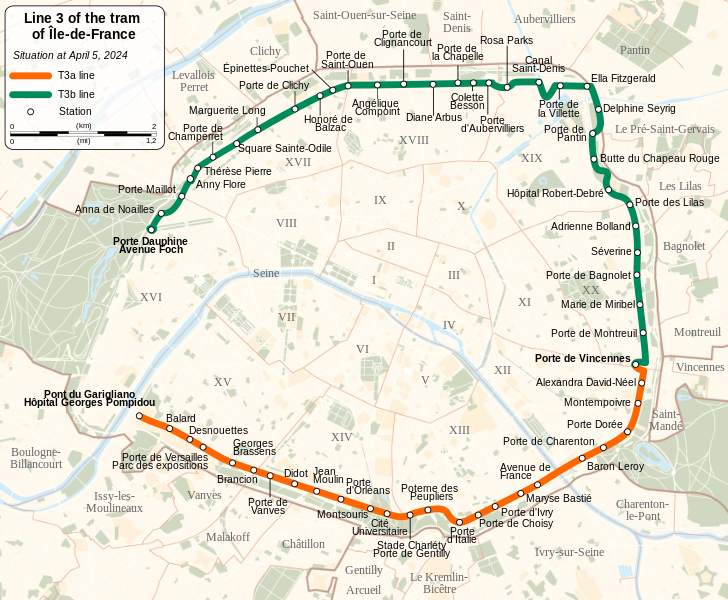
Line extension
Paris authorities and RATP did not stop on building just the southern segment of the line. At the moment the extension is under constrution along the eastern boundary of the city to the north up to Porte de la Chapelle. The principles remain the same: connecting peripheral neighborhoods and metro stations with convenient public transport; prioritizing the trams; reducing car traffic and renovating the streetscape.
A notable moment: in the building process a lot of car infrastructure is being removed. One overpass have been demolished already and some tunnels that allow free passage under intersections will be closed and filled up. This approach shows us that in Paris car traffic is not the holy cow which once allowed in the city cannot be reduced. The cars though are not banished from the streets which would be problematic but tamed and kept on a short leash.
More information on the extension of line T3 can be found on the official website of the project. Although it is solely in French it is still very informative with lots of pictures.
Afterword
You have probably thought while reading this post that this project being top-notch must be very expensive. But everything is relative. The cost of construction of this 7,9 km long line was 311 million euro. That includes the rolling stock. So it is about 40 mil. euro per kilometer. Not a while a go an estimated price tag was published for the 2nd metro line in Yekaterinburg and it is 200 mil. euro per kilometer. So, building a high-end tramway line with full renovation of adjacent streetspace costs at least 5 times less than building a conventional subway. I wouldn’t jump to conclusions in this post but I think that’s a fact worth thinking over.
An at the end let’s see some video footage of T3 line:
